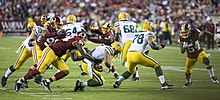Blitz (American Football)

Blitz is the name of a defensive game strategy in American football in which one or more defensive players are used in addition to the normal pass rush . Usually only the defensive line puts pressure on the opposing offensive line and the quarterback standing behind it . In lightning she is supported by linebackers and / or the defensive backfield .
With this, the defense wants to create an excess weight on the line and enable its own player to advance to the quarterback, at best to achieve a quarterback sack , to provoke a fumble , or to tackle the running back in the backfield with loss of space . Another goal is to upset the timing between the quarterback and his receivers , forcing him to make an imprecise pass.
A flash is usually carried out by linebackers, but can also be started by safeties or cornerbacks . This maneuver, known as the safety or cornerback flash, is riskier, however, as it can create dangerous gaps in the deep pass defense that can be exploited by a well-rehearsed quarterback receiver team.
The name Blitz comes from German and is derived from Blitzkrieg , a combat strategy of the Second World War .
history
Don Ettinger , a defender for the New York Giants , is believed to be the inventor of lightning during his brief National Football League (NFL) career from 1948 to 1950.
Larry Wilson , Free Safety of the Arizona Cardinals from 1960 to 1972, expanded the play and perfected the safety blitz , a play that was originally known as "Wildcat". But the defensive coordinator Chuck Drulis is also often portrayed as the inventor of the safety lightning bolt.
variants
As a zone flash a particular variant is called, in which a defensive line player at the beginning of the play to the original position of a flashing linebackers or defensive backs can fall back (to defend against a Passspielzug) and takes over its defensive zone. The aim of this maneuver is to confuse the block assignment of the offensive line in such a way that nobody feels responsible for the flashing player and that he can more easily get through to the quarterback. Bill Arnsparger is considered to be the inventor of this variant when he coached the Miami Dolphins in 1971 . Dick LeBeau developed it further with the Cincinnati Bengals in the late 80s and perfected it in the 90s with the Pittsburgh Steelers in such a way that the team was also known as the Blitzburgh at the time . Today, Zone Blitz formations can be found in almost all defense playbooks in the NFL.
Strategies against lightning
On the one hand, there is the so-called West Coast Offense, an offensive system based on fast, short passes. This system has a natural advantage over a flashing defense because the quarterback now has one less pass defender in front of him.
Second, the offense can attempt to respond to lightning by throwing the quarterback into the zone that the defending defender normally defends.
If the quarterback detects the lightning early, the quarterback can use a so-called "call" to signal to his running back or tight end that he should not run a pass route, but also tries to block the advancing defenders.
literature
- Stephan Faust, Markus Hederer (Red.): American Football. The official rules. Interesting facts from A to Z. Falken, Niedernhausen / Ts. 2000, ISBN 3-8068-1673-5 .
Web links
- Larry Wilson in the Hall Of Fame (English)